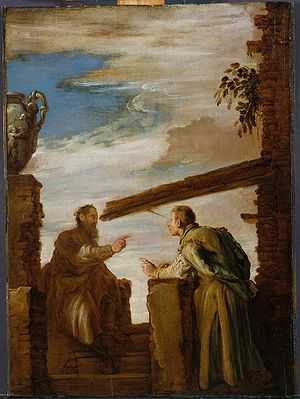The Mote and the Beam

The Mote and the Beam (also called discourse on judgmentalism) is a proverbial saying of Jesus given in the Sermon on the Mount.[1] in the Gospel of Matthew, chapter 7, verses 1 to 5. The discourse is fairly brief, and begins by telling his disciples not to judge others, arguing that they too would be judged by the same standard. The Sermon on the Plain has a similar passage in Luke 6:37–42.[2]
Narrative
The New Testament text is as follows:
1 Judge not, that ye be not judged.
2 For with what judgment ye judge, ye shall be judged: and with what measure ye mete, it shall be measured to you again.
3 And why beholdest thou the mote that is in thy brother's eye, but considerest not the beam that is in thine own eye?
4 Or how wilt thou say to thy brother, Let me pull out the mote out of thine eye; and, behold, a beam is in thine own eye?
5 Thou hypocrite, first cast out the beam out of thine own eye; and then shalt thou see clearly to cast out the mote out of thy brother's eye.
The first two verses use plural "ye" and "you", and the next three verses use the singular "thou", "thy" and "thine" to the individual. (Luke 6:41 also uses "thou" after using "ye" in Luke 6:37.)
Interpretation
The moral lesson is to avoid hypocrisy, self-righteousness, and censoriousness. The analogy used is of a small object in another's eye as compared with a large beam of wood in one's own. The original Greek word translated as "mote" (κάρφος karphos) meant "any small dry body".[3] The terms mote and beam, more common in Early Modern English, are from the King James Version and are equivalent in modern speech to the words "speck" and "board", respectively.
In the analogy, the one seeking to remove the impediment in the eye of his brother always has the larger impediment in his own eye, suggesting that the greater blindness and hypocrisy usually belongs to the one who attempts to regulate his brother.
A proverb of this sort was familiar to the Jews and appears in numerous other cultures too.[4] Herbert Lockyer noted a similar idea in the work of Scottish poet Robert Burns, who wrote in "To a Louse":[5]
Oh, wad some Power the giftie gie us,
To see ourselves as others see us!
See also
References
| Wikimedia Commons has media related to The Parable of the Mote and the Beam. |
- ↑ Matthew by Charles H. Talbert 2010 ISBN 0-8010-3192-3 page 93 view 93
- ↑ Steven L. Cox, Kendell H. Easley, 2007 Harmony of the Gospels ISBN 0-8054-9444-8 page 72 view 72
- ↑ Henry Liddell and Robert Scott, A Greek-English Lexicon: κάρφος .
- ↑ James Hastings, "Beam and Mote", A Dictionary of Christ and the Gospels 1 text source
- ↑ Herbert Lockyer (1988), All the Parables of the Bible, pp. 151–152, ISBN 978-0-310-28111-5
| The Mote and the Beam | ||
| Preceded by The Birds of Heaven in the Sermon on the Mount |
New Testament Events |
Succeeded by Discourse on the Two Ways in the Sermon on the Mount |